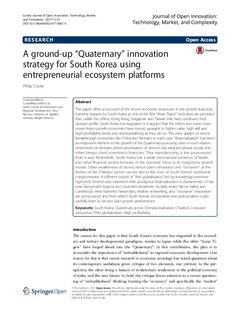| dc.contributor.author | Cooke, Philip | |
| dc.coverage.spatial | South Korea | nb_NO |
| dc.date.accessioned | 2019-10-04T08:28:50Z | |
| dc.date.available | 2019-10-04T08:28:50Z | |
| dc.date.created | 2018-01-29T10:37:03Z | |
| dc.date.issued | 2017 | |
| dc.identifier.citation | Cooke, P. (2017). A ground-up “Quaternary” innovation strategy for South Korea using entrepreneurial ecosystem platforms. Journal of Open Innovation: Technology, Market, and Complexity, 3(10). | nb_NO |
| dc.identifier.issn | 2199-8531 | |
| dc.identifier.uri | http://hdl.handle.net/11250/2620231 | |
| dc.description.abstract | This paper offers an account of the recent economic slowdown in the growth trajectory formerly enjoyed by South Korea as one of the first “Asian Tigers”. Indicators are provided that, unlike the others, Hong Kong, Singapore and Taiwan that have continued their upward profile, South Korea has stagnated. It is argued that the others and some more recent Asian growth economies have moved upwards to higher value, high skill and high profitability levels and deindustrialising as they did so. This even applies to recent breakthrough economies like China and Vietnam. In each case, “financialization” has been an important element in the growth of the Quaternary economy, even in such relative newcomers as Vietnam, where privatization of services has attracted private equity and other foreign direct investment financiers. Thus manufacturing is less pronounced than it was. Meanwhile, South Korea has a weak international presence of banks and other financial sectors because of the domestic focus in its indigenous growth model. Other weaknesses of closed versus open innovation and “cronyism” at the behest of the Chaebol system can be laid at the door of South Korea’s traditional conglomerates. A different model of “thin globalisation” led by knowledge-intensive high-tech, biotech and cleantech with prodigious financialization is characteristic of the new fast-growth regions and countries elsewhere, notably Israel, Silicon Valley and Cambridge. Here flattened hierarchies, reliable networking, and “crossover” innovation are pronounced and from which South Korean industrialists and policymakers could usefully learn to recover past growth performance. | nb_NO |
| dc.language.iso | eng | nb_NO |
| dc.publisher | MDPI | nb_NO |
| dc.rights | Navngivelse 4.0 Internasjonal | * |
| dc.rights.uri | http://creativecommons.org/licenses/by/4.0/deed.no | * |
| dc.subject | South Korea | nb_NO |
| dc.subject | Quaternary sector | nb_NO |
| dc.subject | Deindustrialisation | nb_NO |
| dc.subject | Chaebol | nb_NO |
| dc.subject | Crossover innovation | nb_NO |
| dc.subject | Thin globalisation | nb_NO |
| dc.subject | High profitability | nb_NO |
| dc.title | A ground-up “Quaternary” innovation strategy for South Korea using entrepreneurial ecosystem platforms | nb_NO |
| dc.type | Journal article | nb_NO |
| dc.type | Peer reviewed | nb_NO |
| dc.description.version | publishedVersion | nb_NO |
| dc.rights.holder | © The Author(s). 2017 | nb_NO |
| dc.subject.nsi | VDP::Samfunnsvitenskap: 200::Økonomi: 210 | nb_NO |
| dc.source.volume | 3 | nb_NO |
| dc.source.journal | Journal of Open Innovation: Technology, Market, and Complexity | nb_NO |
| dc.source.issue | 10 | nb_NO |
| dc.identifier.doi | 10.1186/s40852-017-0061-4 | |
| dc.identifier.cristin | 1554130 | |
| cristin.unitcode | 203,2,13,0 | |
| cristin.unitname | Senter for nyskaping - Bergen | |
| cristin.ispublished | true | |
| cristin.fulltext | original | |
| cristin.qualitycode | 1 | |

